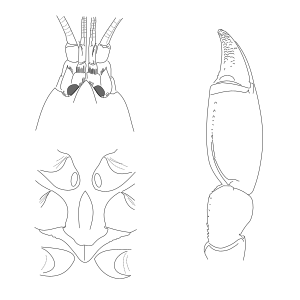Engaewa similis facts for kids
Quick facts for kids Engaewa similis |
|
|---|---|
 |
|
| Diagram adapted from Riek, 1967 | |
| Conservation status | |
| Scientific classification | |
| Kingdom: | |
| Phylum: | |
| Subphylum: | |
| Class: | |
| Order: | |
| Family: |
Parastacidae
|
| Genus: |
Engaewa
|
| Species: |
E. similis
|
| Binomial name | |
| Engaewa similis Riek, 1967
|
|
Engaewa similis is a special kind of crayfish that lives only in Australia. It belongs to a family of crayfish called Parastacidae.
Where Does This Crayfish Live?
Engaewa similis is found only in a specific area of Western Australia. This means it is endemic to that region. You can find it around the Augusta area, stretching from the Margaret River all the way to Windy Harbour. This crayfish was once thought to be an endangered species, meaning it was at risk of disappearing. However, scientists now list Engaewa similis as a species of Least Concern on the IUCN Red List. This is good news because it means there are many of them in the places where they live.
What Does It Look Like?
In 1961, a scientist named L. P. Smith found an adult female Engaewa similis in Augusta, Western Australia. This particular crayfish became the holotype. A holotype is like the main example of a species. It is used by scientists to describe and compare other animals of the same kind. In 1967, another scientist, E. F. Riek, wrote a detailed description of this holotype. It is kept at the Western Australian Museum. The holotype was about 36 millimeters (about 1.4 inches) long. Its main body part, called the cephalothorax, was about 16.5 millimeters (0.65 inches) long. This crayfish had blue claws, which are called chela (KEE-luh). It was similar to another crayfish, Engaewa reducta. However, Engaewa similis had a different shape for its rostrum (the pointy part on its head). Its claws and the shape of its telson (tail fan) and uropods (parts of the tail) were also different.


